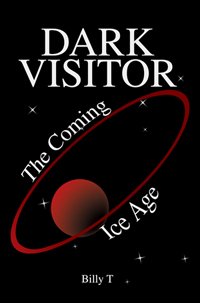
Ice Age to end Global Warming in 2008
Global warming may not be
our problem, if the Harvard educated authors of Dark Visitor
are correct in their prediction that a new Ice Age will begin in 2008.
Prior ice ages have been caused by minor variations in earth's orbit
(<1%) and/or slight changes in solar activity. From minor perturbations
now observed in Pluto's orbit, these authors infer that a small black
hole is approaching the solar system and that it will change earth's
orbit by 8%. Contrary to all prior ice ages, which have taken thousands
of years to develop, the coming ice age will have a very rapid onset.
By 2025, Washington DC will be under approximately 100 feet of ice!
Before that, falling ocean levels will make all ports useless as ice
is stored on land.
Dark Visitor may be just an entertaining scientific hoax. It may be only a vehicle used in a unique, non-textbook style to explain how the climate works and many physical laws. Readers of Dark Visitor will learn how snow delivers tropical heat to Norway, why the prevailing winds in the USA come from the west, etc. While reading this scary story, they will come to understand this and other aspects of the weather and climate.
This WebPage concludes with a section of text from Dark Visitor in which even the complex, climate controlling, Coriolis Force is made crystal clear to the average reader. (Many students have memorized an equation for calculating it, but do not understand its origin or recognize that it is not a true force.) With other specific climatic illustrations, Dark Visitor also explains Taylor Instabilities, thermohaline ocean circulation, heats of evaporation and fusion. An astounding amount of physics is mixed into the story of Dark Visitor. For example, all three of Kepler's laws are explained and used in the analysis, but they are integrated into the scary story and never even named. Because the physical information is an integral part of the narration, the reader will rarely recognize that they are being taught. Dark Visitor is an entertaining way to learn, without effort, about:
Stellar Evolution Theory: (Formation of white dwarfs, red giants, neutron stars, and black holes). Gravity gradient effects: (Why two tides daily, etc.). Pulsars: (Magnetic field compression, Stark Effect pair production, Synchrotron Radiation, Angular Momentum changes, including the rare "glitches" when pulse rate increases, History of pulsar as Little Green Men). Inverse Square Laws: (Both gravity and solar radiation). Central Forces: ("Reduced Mass" approach to scattering). Sun's Future: (a red giant) Dark Matter: (How we know it exists) Coordinate System Transformations. (Translation only) Stephen Hawkin's black holes: (Evaporation of). Magnetic Monopoles: (Experiments to detect). Astronomical Coordinates (orbital elements vs. apparent location). Conservation Laws. (Energy and Momentum) Black Holes (Types and as a speculative source of new universes), Planet Retrograde Motion (Why and when it occurs). The Moon (Why it is moving away). Dark Visitor uses specific propositions from Newton's book (Principles…), presents a three-body orbital-dynamics program with error reducing refinements applicable to all finite time step models -- All this physics is presented as a natural part of a scary and captivating story, without textbook teaching style.